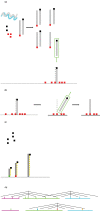g you The direct determination of haplotypes from extended regions of genomic DNA
- PMID: 20370899
- PMCID: PMC2996965
- DOI: 10.1186/1471-2164-11-223
g you The direct determination of haplotypes from extended regions of genomic DNA
Abstract
Background: One of the major obstacles to the exploitation of genetic variation in human medicine, veterinary medicine, and animal breeding is the difficulty in defining haplotypes in unrelated individuals.
Results: We have developed a Multiplex Double Amplification Refractory Mutation System combined with Solid Phase PCR on Fluorescently labelled beads. The process is inherently amenable to automation. It provides a high degree of internal Quality Control, as each PCR product is represented in duplicate on the bead array, and each SNP is tested against multiple partners. This technique can resolve very complex genotypes into their constituent haplotypes; it defined all the alleles at 60 SNP in exon 2 of the ovine DRB1 MHC locus in a sample of 109 rams. These 60 SNP formed 33 DRB1 exon 2 alleles; two of which had not been previously identified; although both of them have been independently confirmed.
Conclusion: This technique has the same resolution as allele specific sequencing. Sequencing has the advantage of identifying novel polymorphic sites but where all SNP sites have been identified this novel procedure can resolve all alleles and haplotypes and identify novel combinations of polymorphisms. This method is similar in price to direct sequencing and provides a low cost system for direct haplotyping of extended DNA sequences.
Figures




Similar articles
-
Direct micro-haplotyping by multiple double PCR amplifications of specific alleles (MD-PASA).Nucleic Acids Res. 2002 Jun 15;30(12):e62. doi: 10.1093/nar/gnf062. Nucleic Acids Res. 2002. PMID: 12060700 Free PMC article.
-
Identification of DRB alleles in rhesus monkeys using polymerase chain reaction-sequence-specific primers (PCR-SSP) amplification.Tissue Antigens. 1999 Sep;54(3):254-63. doi: 10.1034/j.1399-0039.1999.540306.x. Tissue Antigens. 1999. PMID: 10519362
-
ADLAPH: A molecular haplotyping method based on allele-discriminating long-range PCR.Genomics. 2004 Sep;84(3):600-12. doi: 10.1016/j.ygeno.2004.06.003. Genomics. 2004. PMID: 15498468
-
Systematic analysis of swine leukocyte antigen-DRB1 nucleotide polymorphisms using genomic DNA-based high-resolution genotyping and identification of new alleles.Tissue Antigens. 2011 Jun;77(6):572-83. doi: 10.1111/j.1399-0039.2011.01662.x. Epub 2011 Apr 4. Tissue Antigens. 2011. PMID: 21457149
-
Single-molecule analysis for molecular haplotyping.Hum Mutat. 2004 May;23(5):442-6. doi: 10.1002/humu.20020. Hum Mutat. 2004. PMID: 15108275 Free PMC article. Review.
Cited by
-
Variation in the IGF2 gene promoter region is associated with intramuscular fat content in porcine skeletal muscle.Mol Biol Rep. 2012 Apr;39(4):4101-10. doi: 10.1007/s11033-011-1192-5. Epub 2011 Jul 21. Mol Biol Rep. 2012. PMID: 21779802
References
-
- Martinez-Arias R, Bertranpetit J, Comas D. Determination of haploid DNA sequences in humans: application to the glucocerebrosidase pseudogene. DNA Sequence. 2002;13:9–13. - PubMed
Publication types
MeSH terms
Substances
LinkOut - more resources
Full Text Sources
Research Materials

